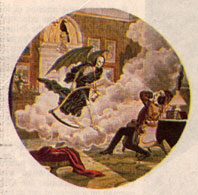Joanna Connors, the Cleveland Plain Dealer, October 22, 2000
Before there was DVD, there was video. Before there was video, there was television. Before there was television, there were movies
And before there were movies, there was magic.
The magic was live. It came from lanterns and slides, some of which moved. It came from performers who told stories while the slides provided the pictures. And it came from audiences, who yelled and cackled and stomped their feet, adding true homemade sound effects to the show they were watching.
There were called magic-lantern shows, and they were as much a part of late 19th-century life as VCRs are to today. This afternoon and tonight, the Cleveland Cinematheque brings it all back with two shows by American Magic-Lantern Theater, a touring company that presents authentic 1890s shows using vintage slides and equipment.
The show, with live music and such familiar fare as a dramatization of Edgar Allan  Poe's "The Raven," is pretty much what an audience in the 1890s would have seen when they went out for a show, said Terry Borton, the creator of American Magic-Lantern Theater and its projectionist-showman-narrator.
Poe's "The Raven," is pretty much what an audience in the 1890s would have seen when they went out for a show, said Terry Borton, the creator of American Magic-Lantern Theater and its projectionist-showman-narrator.
"Our audiences experience it as the Victorians would have experienced it," he said. "We like to say that we don't make fun of the Victorians, we have Victorian fun. And people enjoy that and get into the spirit of it."
You could say the Borton has magic lanterns in his blood. "My great-grandfather had a magic lantern and gave little neighborhood shows," he said. "And the lantern and slides got passed down through the family. When I was a kid in the '40s, that's what we did on rainy days, especially around Christmas. My dad would pull out the magic lantern and give shows."
When the family magic lantern was passed on to him, Borton continued the tradition with his children. He did a few community shows, and, he said, "got hooked." He turned it into a profession eight years ago, and since then has been spreading the magic all across the country in shows like the ones at the Cinematheque.
The first show, at 3:30 this afternoon, is Borton's "Victorian Halloween Show." The centerpiece of the show is "The Raven," which Borton said is a "spectacular" set of 24 slides by Joseph Boggs Beale, a magic-lantern slide-maker and performer whom Borton said deserves to be known as "America's first great screen artist."
"'The Raven' was really popular in its time," Borton said. "It's one of the few 19th-century pieces that people know, so I avoided doing it for quite a while. But it makes an extraordinary piece, because you see and hear this man going crazy before your eyes."
Also on the program is the ever-popular "Ratcatcher," in which a rat approaches a snoring man's open mouth and…well, it wouldn't be fair to reveal the ending.
The hour and a half show includes songs and illustrated stories with such familiar refrains as "The goblins will get you if you don't watch out!" and "The worms crawl in, the worms crawl out," and ends with a parade of ghosts and goblins that Borton describes, with pride, as "quite a little turmoil -- general pandemonium."
The 7 p.m. show includes a shortened version of the Halloween program, followed by an illustrated lecture about magic-lantern shows, "Cinema Before Film." Borton, who is writing a book with the same title, is an authority on the subject.
For instance, magic-lantern shows gave us the word "limelight," he said. "The light for the lanterns came from limestone, which was lit up with gases so that it became incandescent."
Magic-lantern shows also pioneered much of what we think of as cinematic technique, he said. "Dissolves, wipes, close-ups, fades, continuity, editing, dramatic lighting, deep space and shallow space -- about 75 percent of the art of the movie was developed at these shows," he said.
The history of magic-lantern shows is fuzzy, but they are thought to have started in about 1650, in the Netherlands. By the late 19th century, they were household items. "It was a very common 'gentleman's philosophical toy,'" Borton said. "Philosophical had a broader meaning than it does today, and they got a huge catalog of philosophical instruments. They were very common in middle-class families, wither for papa or for the children. They were as common as Sega games or VCRs today. Everybody had one."
So, perhaps, sometime in 2100, Borton's own great-grandchild will have a touring show, "The Videotape Show," to which audiences will flock to experience antique entertainment as they once did in the 1990s. Of course, then he'd have to present it to audiences of one and two, in darkened recreation rooms.
Links of Interest:
-
The American Magic Lantern Theatre
Visit the site of America's only professional theater company recreating Magic Lantern Shows.
The Getty
The Getty has a wonderful new exhibit, "Devices of Wonder." Even better, much of the exhibition is available for playing with online! There are a host of devices of interest to early moving picture fans; don't miss the interactive Thaumatropes, Chromatrope, Crank Magic Lantern, vues d'optique, and an early film by Thomas Edison. Requires Flash and RealPlayer to fully experience. It's a lot of fun; definitely visit and enjoy!
Early Cinema
Artifacts, factoids, a timeline, biography, encyclopedia, and more memorialized at this wonderful site focusing on early film history.
Professor Hall's Silent Movies
Explores the roots of film history, beginning as early as Magic Lanterns.